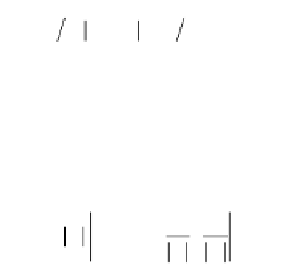Graphics Reference
In-Depth Information
Figure 6.17.
The area of a parallelogram and volume of a parallelopiped.
u
v
w
Ê
ˆ
Á
Á
˜
˜
(
)
V =¥
uv•w
=
det
.
(6.28)
Ë
¯
Proof.
By a rigid motion we can arrange it so that
u
and
v
lie in the plane
R
2
.
The first equality follows from the fact that V is the product of the height of the
parallelopiped and the area of its base. See Figure 6.17(b). The second equality is a
property of the triple product.
Note that Formula 6.7.1 is a special case of Formula 6.7.2 where we let
w
=
e
3
.
The area A of a triangle defined by two vectors
u
and
v
in
R
2
6.7.3
Formula.
is
given by
u
v
A =
()
¥=
()
Ê
Ë
ˆ
¯
12
uv
12
det
.
(6.29)
Proof.
This is an immediate corollary of Formula 6.7.1. Of course, we could also
use the well-known formula
=
()(
)(
)
A
12
length of base
height
v•
u
u
u
u
-
Ê
Ë
ˆ
¯
=
()
12
uv
.
(The height is just the length of the orthogonal complement of
v
with respect to
u
.)
6.7.4
Formula.
The area A of a polygon defined by points
p
0
,
p
1
,...,
p
n
,
p
n+1
=
p
0
in
R
2
is given by






